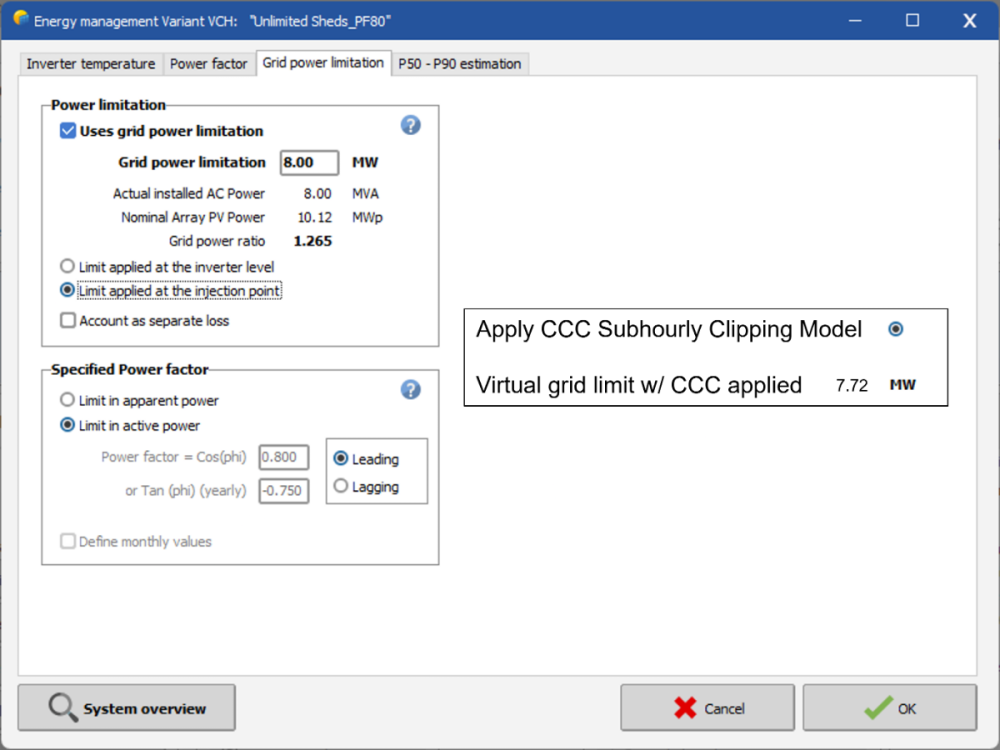
kjs55
Members-
Posts
149 -
Joined
-
Last visited
Recent Profile Visitors
The recent visitors block is disabled and is not being shown to other users.
-
PVsyst V8.0.12: Hello, the "Operating losses at STC" sections of the PVsyst V8 output PDF report have disappeared (!). See below screenshots as example (V8 screenshot is missing the section; V7 screenshot contains the section on the right-hand side). (NB: Please note the value for Iron Loss Fraction in one of the screenshots is incorrect, as there was a typo in the input. This rapid example was for screenshot purposes only.)
-
There are common instances when we would apply different "soiling" assumptions (which includes dust, snow, etc.) for different PV module types (e.g., monofacial, bifacial). We would like the ability to apply a different set of monthly soiling values for each subarray in PVsyst V8. This would resemble the subarray dropdown menu for the MQA factor in Detailed Losses. Is it on the development roadmap? Thanks.
-
Hi, I'd like to specifically request a 10-min. editing time as an incremental (and meaningful) improvement. Thank you!
-
PVsyst V8 Problem Statement: How to apply spectral adjustments to certain subarrays (containing certain PV module cell types) and *not* to others? Ideas (example only): 1.) This could be handled in the PV module PAN file, through a checkbox which (if checked) will apply spectral adjustments IF the tab in Detailed Losses is applied 2.) This could be handled as a dropdown menu for each subarray on the spectral adjustment tab in Detailed Losses, similar to the MQA factor subarray dropdown menu, where you can toggle on/off spectral adjustments for each subarray 3.) (Least favorite option): If the spectral adjustment tab of Detailed Losses is applied, it could automatically apply spectral adjustments onto the specific technologies involved in each subarray according to PV cell technology type. This is the least favorite option, because not all PV cell technologies should use spectral adjustments (e.g., single-junction Si-based technologies). Conversely (and preferably), Options 1 and 2 above would allow the user to *only* apply spectral adjustments onto the (sub)set of PV cell technologies in the applicable subarrays which require spectral adjustments. Thank you!
-
Here's one way CCC could be incorporated into PVsyst, to enable more accurate modeling with standard hourly TMY datasets:
-
Let's imagine you have a 100 MWdc PV system with: - Split Si PV module design using half-cut PV cells in Orientation #1 with split partitioning, and - CdTe PV module design in Orientation #2 with no split partitioning How do you assign: - "according to module strings" with 100% "fraction for electrical effect" for Orientation #1, and - "linear shadings" for Orientation #2 ? Please advise. Thanks.
-
Suggestion to add a third option for the ac losses power reference value, namely, a custom user-defined input value field. The reason for this is that sometimes ac losses are not defined at either of the two (2) presently available toggle options in PVsyst, namely, "PNomPV(ac) at STC" or "PNom (inverters)", but rather at some other ac losses power reference value (e.g., driven by the grid limit). Thanks.
-
Apologies if this is documented somewhere and I missed it (if so, please feel free to point me to the already existing answer). Are "secondary parameters" used in PVsyst's numerical simulations? Or, are these just informative settings? The only help documentation I can find says: "Secondary parameters": sometimes useful parameter. I'm not sure how to interpret this. Please advise. Thanks.
-
Apologies if this is documented somewhere and I missed it (if so, please feel free to point me to the already existing answer). Would you please explain how the internal transformer settings in the PVsyst .OND file are applied? Or, are these just "informative" settings? Thanks.
-
P.S. Please note the 5xxxx3 MWh value also shows up in the Report on the Loss Tree, in the "Balances and main results" table, etc.
-
PVsyst v7: Sum over E_Grid 8760 is 5xxxx2.3 MWh, which rounds to 5xxxx2 MWh. NB: 8760 has night losses. PVsyst Loss Tree (copied to Clipboard and pasted into Excel) yields 5xxxx3 MWh (no decimal places provided). If you remove one row from the 8760 summation, you get 5xxxx2.5 MWh, which rounds to 5xxxx3 MWh. So this tells me the PVsyst Loss Tree is missing a single row from its summation (namely, it's summing 8759 rows, not all 8760 rows). Please confirm it. (NB: Exact values masked for confidentiality reasons.)
-
PVsyst v7 & v8: In the PVsyst Report (output PDF file), please note the ambient temperature of all inverter power ratings. For example, please include: Unit Nom. Power (~>50 oC) = 765 kWac where the "at 50 oC" is added. Similar to: Max. power (~> 25 degC) = 840 kWac Please see attached screenshot. Thank you!







-Copy.png.a79629189f1d8e9b6c531b86a32afb1b.png)